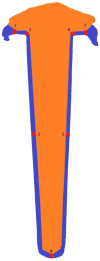Evaluation of Internal Fit in Custom-Made Posts and Cores Fabricated with Fully Digital Versus Conventional Techniques
- PMID: 39728189
- PMCID: PMC11676165
- DOI: 10.3390/jfb15120389
Evaluation of Internal Fit in Custom-Made Posts and Cores Fabricated with Fully Digital Versus Conventional Techniques
Abstract
Objective: This study aimed to assess and compare the internal fit of custom-made posts and cores fabricated using digital impressions (DI) and conventional vinyl polysiloxane (VPS) impressions in restorative dentistry.
Materials and methods: A typodont tooth model, simulating the anatomy of the root canal of a central incisor, was utilized for the study. Two groups were formed, Group A and Group B, and each group provided a total of 18 impressions of two types: DIs and VPS impressions. In Group A, posts and cores (PCs) were fabricated using Selective Laser Melting (SLM) from the DIs. Meanwhile, in Group B, conventionally cast (CC) PCs were created from the VPS impressions. Silicone replicas of the internal surfaces were produced, and measurements were made at seven different points for each group. A statistical analysis was performed to assess the differences in internal fit between the two impression techniques.
Results: The results revealed a statistically significant difference in mean internal fit between Group A (DI and SLM) and Group B (VPS and CC), with Group A exhibiting a mean internal fit of 182.6 µm and Group B showing a mean of 205.9 µm. While both groups demonstrated considerable variability in internal fit measurements, the digital impression technique showed promise for achieving superior internal fit, with a significantly greater fit for measuring points on sides and the most apical part of the post for Group A. Variations were observed across different measuring points, emphasizing the impact of impression technique on specific regions within the tooth.
Conclusion: This study contributes to the growing body of knowledge in digital dentistry by highlighting the potential benefits of DIs in achieving a superior internal fit for custom-made PCs. Clinicians may consider the advantages of digital techniques to enhance the precision of their restorative procedures, although further research is warranted to evaluate the clinical impact of these findings.
Keywords: computer-aided design; dental fit; dental impression technique; digital dental technology; post-and-core technique; vinyl polysiloxane.
Conflict of interest statement
The authors declare no conflicts of interest.
Figures




Similar articles
-
Comparative analysis of the fit quality of monolithic zirconia veneers produced through traditional and digital workflows using silicone replica technique: an in vitro study.BMC Oral Health. 2024 Dec 28;24(1):1566. doi: 10.1186/s12903-024-05361-9. BMC Oral Health. 2024. PMID: 39732646 Free PMC article.
-
Marginal Fit of Single-Crown and Three-Unit Fixed Dental Prostheses Fabricated From Digital and Conventional Impressions: An In Vitro Cross-Sectional Study.Cureus. 2024 Nov 10;16(11):e73408. doi: 10.7759/cureus.73408. eCollection 2024 Nov. Cureus. 2024. PMID: 39664124 Free PMC article.
-
Clinical Acceptance of Digitally Produced Zirconia and Metal Post and Cores, Based on the Impression Method.Clin Pract. 2024 Nov 20;14(6):2533-2541. doi: 10.3390/clinpract14060199. Clin Pract. 2024. PMID: 39585027 Free PMC article.
-
The accuracy of different dental impression techniques for implant-supported dental prostheses: A systematic review and meta-analysis.Clin Oral Implants Res. 2018 Oct;29 Suppl 16:374-392. doi: 10.1111/clr.13273. Clin Oral Implants Res. 2018. PMID: 30328182
-
Evaluation of the methods for determining accuracy of fit and precision of RPD framework in Digital (3D printed, milled) and conventional RPDs - a systematic review.BMC Oral Health. 2024 Dec 4;24(1):1466. doi: 10.1186/s12903-024-05262-x. BMC Oral Health. 2024. PMID: 39633297 Free PMC article.
References
-
- Raman Mishra D., Shetty V.S., D’Costa V.F., Shetty K.H. Evolution of Posts—From Rigidity to Flexibility. Int. J. Sci. Res. IJSR. 2017;6:2671–2677.
-
- Duret F. Computers in dentistry. Part two. François Duret—A man with vision. J. Can. Dent. Assoc. 1988;54:664. - PubMed
Grants and funding
LinkOut - more resources
Full Text Sources
Miscellaneous

